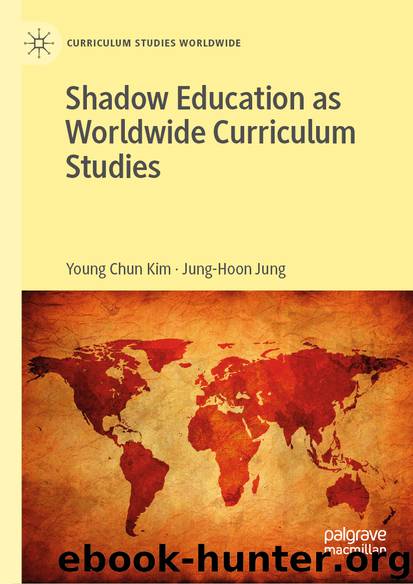Shadow Education as Worldwide Curriculum Studies by Young Chun Kim & Jung-Hoon Jung

Author:Young Chun Kim & Jung-Hoon Jung
Language: eng
Format: epub
ISBN: 9783030039820
Publisher: Springer International Publishing
Personalized Learning
Shadow education provides students with personalized learning (Kim, 2016; Kim & Kim, 2012, 2015; Mawer, 2015; Ozaki, 2015). Ideally, personalized learning enables all students to have equal access to quality education according to their individual needs and interests. In reality, modern schooling is limited in its ability to meet students’ individual needs (Kim, 2003; Ozaki, 2015). A 2008 Japanese government survey revealed that two-thirds of parents attributed the growing role of juku to the lack of personalized learning in public schools. Ozaki (2015) found that juku teachers appeal to students more than public school teachers, possibly because of their attention to individual needs. Kim (2016) found similar results in South Korea .
Schools are unable to effectively personalize education for two main reasons. First, they have larger class sizes: On average, classes in OECD countries include 21.1 students in elementary schools and 23.3 students in junior high schools (Education at Glance, OECD, 2017); classes in developing countries are much larger. Considerable research has shown that personalized learning is not effectively practiced in overly large classrooms (Kim, 2016; Yang & Kim, 2010). School teachers find it difficult to provide personalized learning due to the wide range of academic achievement , ability, aptitude, preferred learning styles, and background knowledge among students. Additionally, students may hesitate to ask questions because they fear this may interfere with the teacher’s lecture or be seen as a threat to the teacher’s authority; they may prefer to take questions and learning difficulties to shadow education instructors (Kim, 2003, 2016; Yang & Kim, 2010). Second, the bureaucracy of school systems prevents effective personalized learning in countries such as Japan and South Korea , where school curricula are very structured. School teachers in these countries are legally obligated to completely cover all the content of the official curriculum (in all subject areas) within a given period of time: This is their primary duty. This institutional pressure forces them to pay more attention to the delivery of the textbook knowledge to the whole class than to make any effort to provide personalized learning (Kim, 2003).
Among the five types of shadow education, three are most likely to stress personalized learning : (1) home-visit private tutoring , (2) private tutoring institutes , and (3) Internet-based private institutes. As discussed in the previous chapter, home-visit private tutoring is the most personalized. Parents often tell the tutor what to teach based on the student’s needs and the purpose for tutoring , such as preparing for entrance exams , increasing school grades, and developing positive self-efficacy and study skills. In South Korea , this kind of tutoring is most commonly used by high school students preparing for the College Scholastic Ability Test (Kim, 2016). Families often spend USD$30,000 or more annually per student on this type of shadow education (Oh My News, 2012).
Private tutoring institutes have much smaller class sizes than schools, which helps them provide personalized learning . Classes average only 8–15 (in some cases 3–5) students—about half the size of public school classes (Kim, 2003).
Download
This site does not store any files on its server. We only index and link to content provided by other sites. Please contact the content providers to delete copyright contents if any and email us, we'll remove relevant links or contents immediately.
| Administration | Assessment |
| Educational Psychology | Experimental Methods |
| History | Language Experience Approach |
| Philosophy & Social Aspects | Reform & Policy |
| Research |
The Art of Coaching Workbook by Elena Aguilar(48066)
Trainspotting by Irvine Welsh(20056)
Twilight of the Idols With the Antichrist and Ecce Homo by Friedrich Nietzsche(17707)
Fangirl by Rainbow Rowell(7834)
Periodization Training for Sports by Tudor Bompa(7329)
Change Your Questions, Change Your Life by Marilee Adams(6641)
This Is How You Lose Her by Junot Diaz(5774)
Grit by Angela Duckworth(4738)
Red Sparrow by Jason Matthews(4668)
Asking the Right Questions: A Guide to Critical Thinking by M. Neil Browne & Stuart M. Keeley(4576)
Paper Towns by Green John(4169)
Room 212 by Kate Stewart(4107)
Ken Follett - World without end by Ken Follett(3973)
The Sports Rules Book by Human Kinetics(3588)
Housekeeping by Marilynne Robinson(3401)
The Motorcycle Diaries by Ernesto Che Guevara(3333)
Introduction to Kinesiology by Shirl J. Hoffman(3301)
Exercise Technique Manual for Resistance Training by National Strength & Conditioning Association(3292)
Double Down (Diary of a Wimpy Kid Book 11) by Jeff Kinney(3273)
